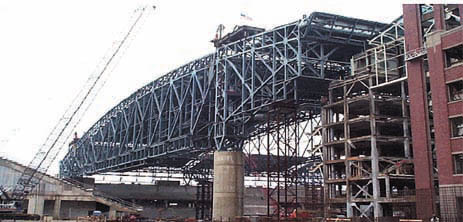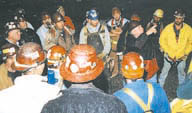New roof truss bridges Ford Field
Date Posted: November 23 2001
What was most likely the heaviest construction lift in the history of the State of Michigan - and one of the heaviest ever in the U.S. - took place on Nov. 2, when a 2,764-ton roof truss section was jacked into place over Ford Field.
The 450-foot long section installed at the west-end of the stadium wasn't built conventionally, and it wasn't lifted conventionally, either. For the last several months, iron workers assembled the massive truss section on what will be the Detroit Lions' playing field. When it was completed, 10 synchronized diesel-powered hydraulic strand jacks moved the section up about 18 inches at a time, where it was anchored at about 180 feet over the stadium.
"We had a glitch or two, but overall, everything went smoothly," said Andrew Duncan, senior project engineer for John Gibson Projects, which handled the hydraulic lift jack operations. A twin truss section at the east end of the stadium is expected to be lifted in a similar manner in December. Additional roof support iron is currently being erected at the roof level between the main trusses.
Duncan said project planners saw big benefits in assembling the Ford Field roof support trusses on the ground.
"Right from the start, you're not exposing the tradesmen to as much danger," he said. Additionally, he said there are cost and time savings from not having to move steel and personnel up and down. And, if the iron were assembled in the air, 10-to-20-story temporary shoring towers would have to be erected, which would have to be built as if they were to be permanently installed - a costly proposition.
"It's safer, and you save time and money," Duncan said. "I think the reason some contractors are continuing to build conventionally is because that's the way they've been doing it for years, and they're unable to think out of the box."
Both Mark Maracle, the general foreman for steel erector Sova/SCI-Steelcon, and Iron Workers Local 25 project steward Robert "Jeep" Eldridge, said up or down, it made little difference to their members where the steel was assembled.
"Even on the ground, we still had to go up to build it," Eldridge said. "Either way, we'd take care of it. They thought it would work better on the ground, so that's what we're doing, and things have worked out fine."
A single operator at the controls of a joystick controlled the lift. All non-essential construction personnel were cleared from the area during the truss-raising.
With the exception of having to drill a few holes so bolts would be aligned properly at the top, and a few other minor glitches, the lift of the truss section "went together great," Maracle said. "It's a nice piece of engineering. Really, it was just like putting up a bridge."
Double-shifts of iron workers and operating engineers working a total of 20 hours a day have moved the project along. Once the final roof truss iron is moved off the existing dirt base of the stadium, another 30 feet of ground will be dug out and leveled in preparation for the playing field. And there will be a roof overhead to keep out the weather.
The project manager at Ford Field is Hunt-Jenkins. The project's steel fabricator/erector Sova/SCI-Steelcon worked with John Gibson Projects and Ruby & Associates, a structural engineering erection consulting firm. Mike Eagan, associate general manager for Ruby and Associates, said they were "very pleased" with the work of the trades
"They've been a very professional group," Duncan agreed.
Si Stroia and Bob Eldridge were instrumental in getting this job on track for the iron workers," said Local 25 BA Nick Siefert. "Plus our guys are doing a good job and they're working safe."

IT TOOK 2 ½ HOURS to lift this 2,764-ton roof truss into place over Ford Field - and most of 2001 to assemble it.

PLACING THE iron worker crew on the morning of the lift is Sova/SCI-Steelcon Project Supt. Si Stroia of Local 25.
